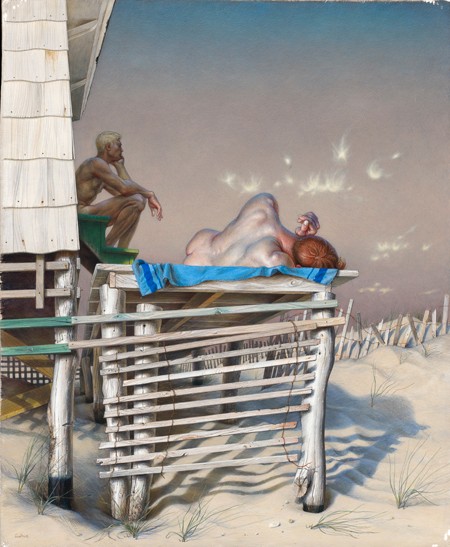During my residency at CASVA, I have made substantial progress toward a chapter-by-chapter book outline for my project “Countermodernism: Reason and Magic in American Art at Mid-Century.” I have also written sections within these chapters, a process that has helped me to organize the various strands of an argument comprising a network of artists, writers, and their associates, in their shared aesthetic, social, familial, and erotic worlds. Since its initial formulation, the project has shifted toward the decade of the 1940s, although the first half of the 1950s remains key as well. Anchored by the figure of Lincoln Kirstein as patron, apologist, and cultural impresario, the project now centers on the almost wholly neglected work of Paul Cadmus (1904–1999) in the 1940s; the archaizing and enigmatic paintings of Jared French (1905–1988) in these same years; the early works of the younger figures Bernard Perlin (1918–2014) and George Tooker (1920–2011); and the photographs of George Platt Lynes (1907–1955). Of this group, only Tooker has received any kind of sustained scholarly attention. Another important body of work is the informal staged photographs of PaJaMa, of which more below.
Invitations to give a series of three talks—including my colloquium at the Center—afforded me an opportunity to test new material on these occasions and to draw together different areas of my research. As a result I now have the argumentative and thematic structure for two of the five chapters. A primary challenge I set for myself in these talks was to develop an understanding of the distinctive but marginally explored aesthetic of the network, centering on poised and posed, tableau-like arrangements of figures in stark landscapes and domestic environments. I have also developed interpretive readings of the enigmatic narrative works by members of the circle, analyzing the sometimes mysterious dynamics and philosophical allegiances of the group.
Before the start of my
Many of my opening questions and hunches have been borne out by my research this year, while other directions have taken on greater prominence. One new area of research is the photographic work of the PaJaMa group, comprising Cadmus and Jared French and his wife, Margaret French. Privately circulated, these intimate, staged photographs have proved immensely fruitful in helping me both to isolate and analyze the peculiar aesthetic practices of the group and to locate these within the complex network of relationships and commitments that bound them together. The aesthetic freshness and interpretive potential of PaJaMa photographs have generated much interest from audiences and interlocutors. Such responsiveness also bears out my sense that the decade of the 1940s has been too narrowly defined around the production of the artists later to be associated with the New York School. My project opens up possibilities for a much expanded, more articulated field of cultural expression than has hitherto characterized our approach to the crucial decade that witnessed World War II and its aftermath.
Having secured a background in the scholarship, biographies, and artistic production of the main figures in the circle, I have in recent weeks turned to the papers of Tooker, for which the Archives of American Art is the primary repository, as well as a series of letters between Cadmus and Webster Aitken. I have also examined the substantial curatorial files for the holdings of the artists in my study at the Smithsonian American Art Museum (SAAM). My CASVA colloquium generated a number of helpful responses from people who knew Kirstein or who pointed to resources and individuals who might be of help. An example is a trove of photographs and contact sheets donated to SAAM by Margaret French in the 1990s. I am in the process of going through this collection—five boxes in all—of which I was unaware until recently. I have also viewed important paintings by Cadmus, French, Tooker, and Perlin that are in storage in Washington museums.
I am also continuing my research in important archival and curatorial/gallery holdings in New York. Two days at Cadmus’s gallery, DC Moore, in lower Manhattan proved extremely productive, as did a short return to the Kirstein archives at the Performing Arts Library of the New York Public Library. The CASVA fellowship allowed me to launch a project I find both compelling and potentially transformative of our understanding of
